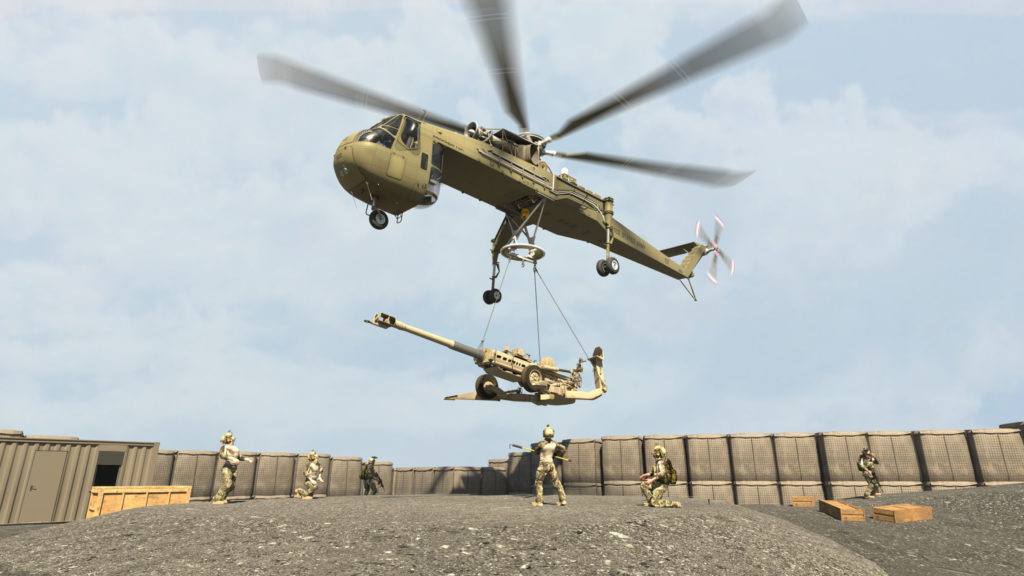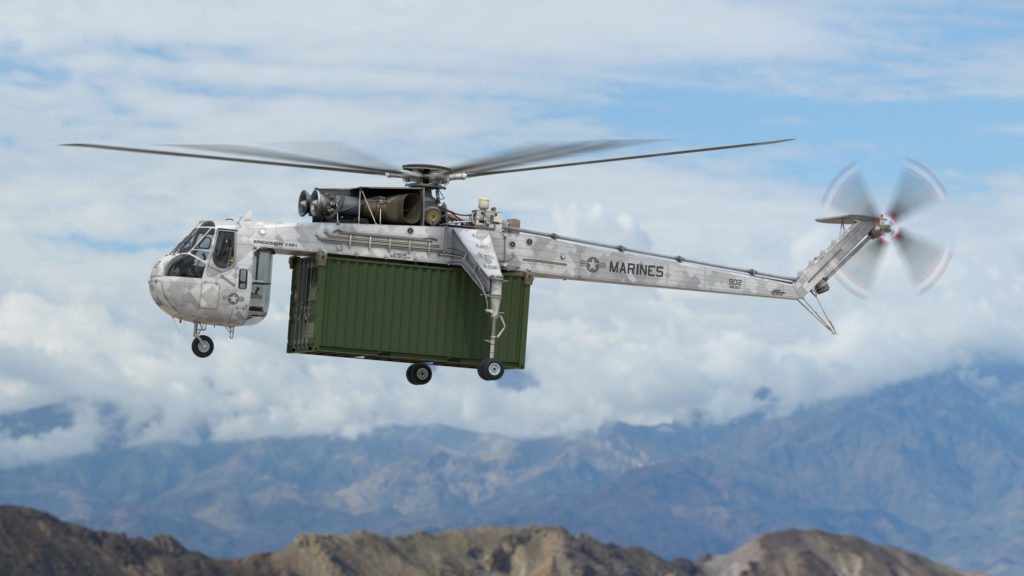Equipped with a new robotic flight control brain, Erickson envisions a souped-up version of the S-64 Air Crane helicopter ferrying vehicles and bulk cargo to U.S. military troops in the field without pilots in the cockpit.
The company has spent the past year disassembling tail number N179AC, better known as “Elvis”, to its metal airframe in preparation for rebuilding it as the first S-64F+. Elvis, named for the shake, rattle and roll of its first job hauling timber, gained fame fighting fire in Australia where in 2001 it helped save the lives of 14 firefighters.
“We’re excited that Elvis lives, but Elvis is getting a bit of a cyborg eyeball,” Jeff Baxter, senior director of research and product development, told Vertical in an interview.

The impetus for upgrading the S-64 was to expand the aircraft’s firefighting capability to nighttime operation and into mountainous terrain with heavier loads, all of which both increase its effectiveness but introduce significant risk for pilots and crew.
“In the possible ways you can do bad things to your life expectancy, we want to be able to do that,” Baxter said. “The whole point of doing that, from our perspective, is to open new markets that have never been done before. In traditional helicopter development, it’s just to do the same sorts of missions either cheaper or with less personnel, but our intention is to do new missions.”
A search for ways of flying the helicopter in perilous conditions more safely pointed Erickson engineers to Sikorsky and its Matrix retrofit autonomy kit. The technology is being developed in conjunction with the U.S. military to relieve pilot cognitive load and is currently being tested on an Army UH-60 Black Hawk.
Sikorsky’s Matrix tech has been in the works since 2013 on the Sikorsky Autonomy Research Aircraft (SARA), a customized S-76B. The system is designed for retrofit onto any aircraft to allow flight with two, one, or no pilots.
“That got us thinking more about the military,” Baxter said. “Firefighting was the beginning, then we got hooked up with Sikorsky. They had this phenomenal thing we could add to our aircraft. Now we’re looking at potentially using it in the military space to do new missions that aren’t done right now.”
No U.S. military service has a formal requirement for an optionally piloted cargo delivery helicopter, especially not one as large as the S-64F+ will be. The Marine Corps saw the benefit of autonomous combat resupply when it employed two Kaman K-MAX helicopters to deliver gear and ammunition to forward operating bases in Afghanistan.

The Army is deep into its testing of Matrix on a modified UH-60A and plans to fly it in autonomous mode this year. Installing Matrix on the S-64 will be a departure from Sikorsky’s in-house applications, but not entirely, as Erickson’s Air Crane was previously the Sikorsky Sky Crane. Returning to military service as an autonomous cargo helicopter, the S-64 would come full circle from its roots as the CH-54 Tarhe, which the Army retired in the 1970s.
As for Sikorsky’s boast that Matrix is retrofittable onto most aircraft, Baxter is impressed.
“The level of design support that we’ve gotten and the relative magnitude of changes I have to make to the aircraft: Totally manageable,” he said. “I think it’s a great platform that lots of people will adopt.”
The S-64 is best suited to the back-end heavy-lift requirements of an expeditionary military force on the move, not frontline combat, Baxter said. S-64s can bypass closed or destroyed ports to transport cargo, vehicles and even troops ashore. Flying point-to-point missions remotely or autonomously will free up pilots for more demanding missions in aircraft — such as the CH-53K and CH-47 Chinook — better suited to frontline duty, he said.
“Automatic logistics, back-end support to front-line fighters, that’s what we think the military application for our aircraft is,” Baxter said.
“It’s the only very large helicopter without a fuselage. You can put anything under this thing,” Baxter added. “There are so many different uses for this airframe because it is like a Swiss Army knife.”
Mark Cooper, Erickson’s vice president of global sustainment, said the Air Crane’s F+ configuration will perform many of the missions the current Air Crane helicopter does well, but more efficiently and at less cost and risk to operators.
Those missions include improving and rebuilding post-conflict infrastructure in emerging democracies, transporting containerized field medical facilities, installing new electrical grids, building roads and debris removal after natural disasters. Autonomous or pilot-optional capabilities will expand the reach and operational environment of the aircraft, Cooper said.
“We already do a lot of this work with our current 64, but the 64+ will bring even greater value,” Cooper said in a recent webinar hosted by Erickson and Rotorcraft Pro. “As we move forward, we will see even more of these opportunities.”
Erickson announced plans to integrate Matrix onto the S-64 at HAI HeliExpo in January 2020 and has made significant headway in preparing its test aircraft since then, Baxter said.

“We’re in the middle of devising the bracketry to mount all the computers and the sensors that detect the world around the aircraft,” Baxter said. “Installation design is in full swing. . . . Riveting has started and engineering is in full swing.”
Deconstruction and reconstruction into the new fly-by-wire configuration should take the rest of 2021 with finishing touches in preparation for ground test scheduled for early 2022, Baxter said. Ground testing and “ a whole bunch” of software will last through most of 2023, with a first flight by year end. The company has budgeted a year for flight test.
“It has a lot of risk,” Baxter said of the development program and test schedule. As with “all aircraft programs . . . there’s a lot of things that can go sideways. We’re actively managing those things, but it looks very promising. We have not yet seen anything besides Covid that has really caused us any significant delay. We’re trucking forwards.”
“I don’t know if it will take us the entire year” for flight test, he added. “It might go more than a year. It’s a tricky program because it’s a completely new flight control system; that’s hard. Then the autonomy stuff on top of that is very difficult.”
Aside from the autonomous fly-by-wire flight controls, Erickson has a laundry list of upgrades that will culminate in the S-64F+ configuration. They include more-modern full-authority digital electronic control (FADEC) engines, composite main rotor blades, advanced cockpit avionics and an improved water cannon. Prioritizing upgrades to the existing fleet of about 50 legacy Air Crane helicopters, Erickson is banking on a mixed government/commercial market for another 50 to 100 aircraft.
Erickson plans to certify the aircraft as a fly-by-wire aircraft like other digitally controlled helicopters. When the time comes to fly it in an autonomous mode, “because the missions demands it and the customer wants to risk the assets . . . that certification portion is ambiguous at this point,” Baxter said.









